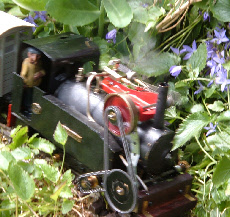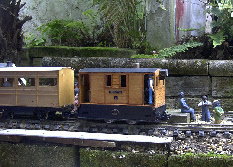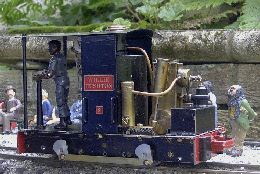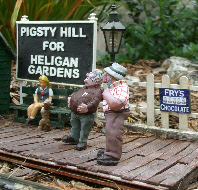
The Situation
The new 45mm gauge Pigsty Hill Light Railway was running (fairly) smoothly, and the
mix of steam and R/C battery locos did their job, but I felt that operation was very
limited -
The New Vision
I decided to specialise on tram and geared locos, and determined to get a Brandbright
tram loco similar to that which I had foolishly sold in the days of the PHLR Mark
One. I also set out to build myself a wooden tram locomotive body, to fit on a battery
chassis. I decided that beloved "Hedgehog", a Roundhouse "Katie", had to go. I also
decided to expand the line to include a "Wye", so I could run out-
The Permanent Way Improvements
I was unsatisfied with the operating potential of the existing line. In particular,
having to back out of the main circuit made life difficult both when operating out
and back and tail-
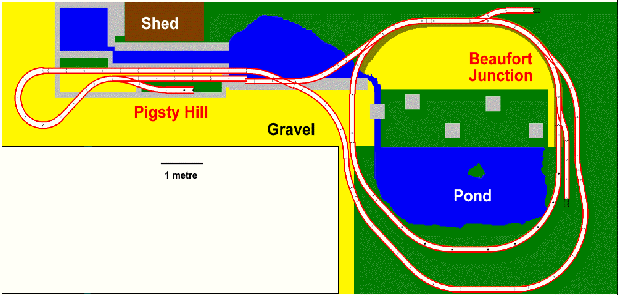
The Thing (aka "Hedgehog")
Increasing frustrated by steam locomotives running out of control, I decided to build
my own geared loco. The result was the Thing -
Go to The Thing -
The Malcolm Moore diesel
I was surprised and delighted to see that Tootle Engineering of Canberra, Australia was making a battery electric model of the Malcolm Moore diesel. This Australian locomotive design, based on a tractor body, was brought to North Borneo by the Australian Army during WWII. A couple stayed on with the North Borneo Railway, and one is preserved in the Railway Museum at Kota Kinabalu.
The price was reasonable, even after the demands of Customs and Post Office, so I bit the bullet and bought one.
This beast did most of the non-
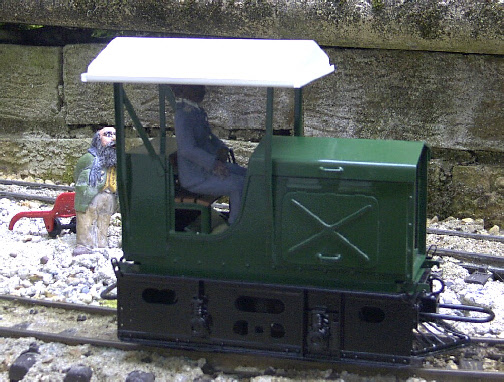
The Regner Konrad or "Babi Jokut"
As so often in the history of the PHLR (the Fowler Resilent, the Wooden Tram and so on), as soon as I built a functioning geared steam locomotive, one came on the market. Messrs. Regner of Aurach, Germany brought out their Konrad, which is everything a real engineer, rather than a bodgeller, would have made of the Thing. Unable to resist it, I ordered one of these from Martin's Models, added a water filler, and now have the most docile and reliable steam loco I have ever owned. It doesn't look bad, either.
I named it "Babi Jokut", which means "bearded pig" in Malay. This animal is native to North Borneo, and its owner, another bearded pig, is native to North Bristol.
Three short videos of the Bearded Pig: Video 1 Video 2 Video 3
BEWARE -
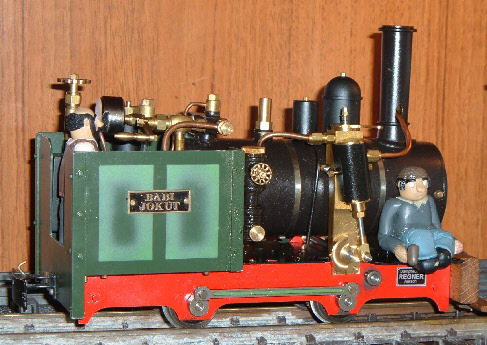
The Simple Coach -
This coach was loosely based on early Darjeeling Himalaya Railway and North Borneo railway coaches. For details of how it was built, see Building Coach No. 4
The Wooden Tram (or the Orange Box)
This was built to fit either a Playmobil or IP dual-
For details of how it was built, see Building the Wooden Tram .
After a review of locomotive policy, PHLR #3 "Fire Fox" was sold off to a railway
in West Sussex. This was the first scratch-
The Steam Tram (or the Coffee-
After much searching, I managed to get hold of a Brandbright Coffee-
It has a vertical boiler, heated by a sort of butane gas ring, which provides steam
to oscillating cylinders, these driving the wheels through 2:1 reduction gears. It
has outside frames, with connecting rods and fly-
They were originally built by Brandbright from components machined by Roundhouse. Unfortunately, mine has lost its maker's plates, but my best guess is that it was built in 1987, like its predecessor.
This was sold on in 2005 to make way for the Regner Konrad. It went to a good home, the new owner even keeping the "Willie Rushton" namplates.
Click here to Find out more about the Coffee-
The Forney
In keeping with the new policy of manual control, PHLR #7 "Harry P Dodge" was sold off to the same railway in West Sussex. This was something of a wrench, as this was a locomotive of which I was very fond, but it seems to have gone to a good home. The new owner lined it out within a day of receiving it, which was nice.
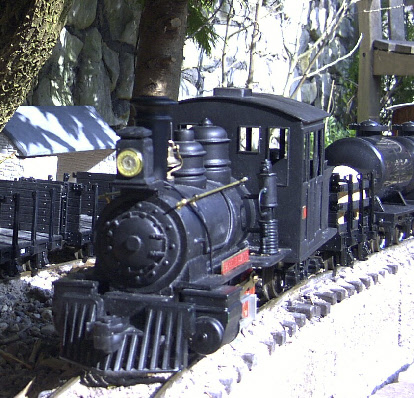
Video clips of the PHLR
These videos of the PHLR MARK III are about 4 Mbytes each, so don't even think about downloading them unless you have broadband or a lot of patience
And this one is ginormous (14.3 Mb), but it shows a complete journey round both loops of the final PHLR Mark IV. If you’ve got broadband, it’s probably worth it.
For images from this period see:
The PHLR Mark III -
The Pigsty Hill Light Railway -
Getting it Right at Last
Warning -
and careful planning, it was in fact the usual shambolic process
that only makes sense in retrospect when tidied up by the author
